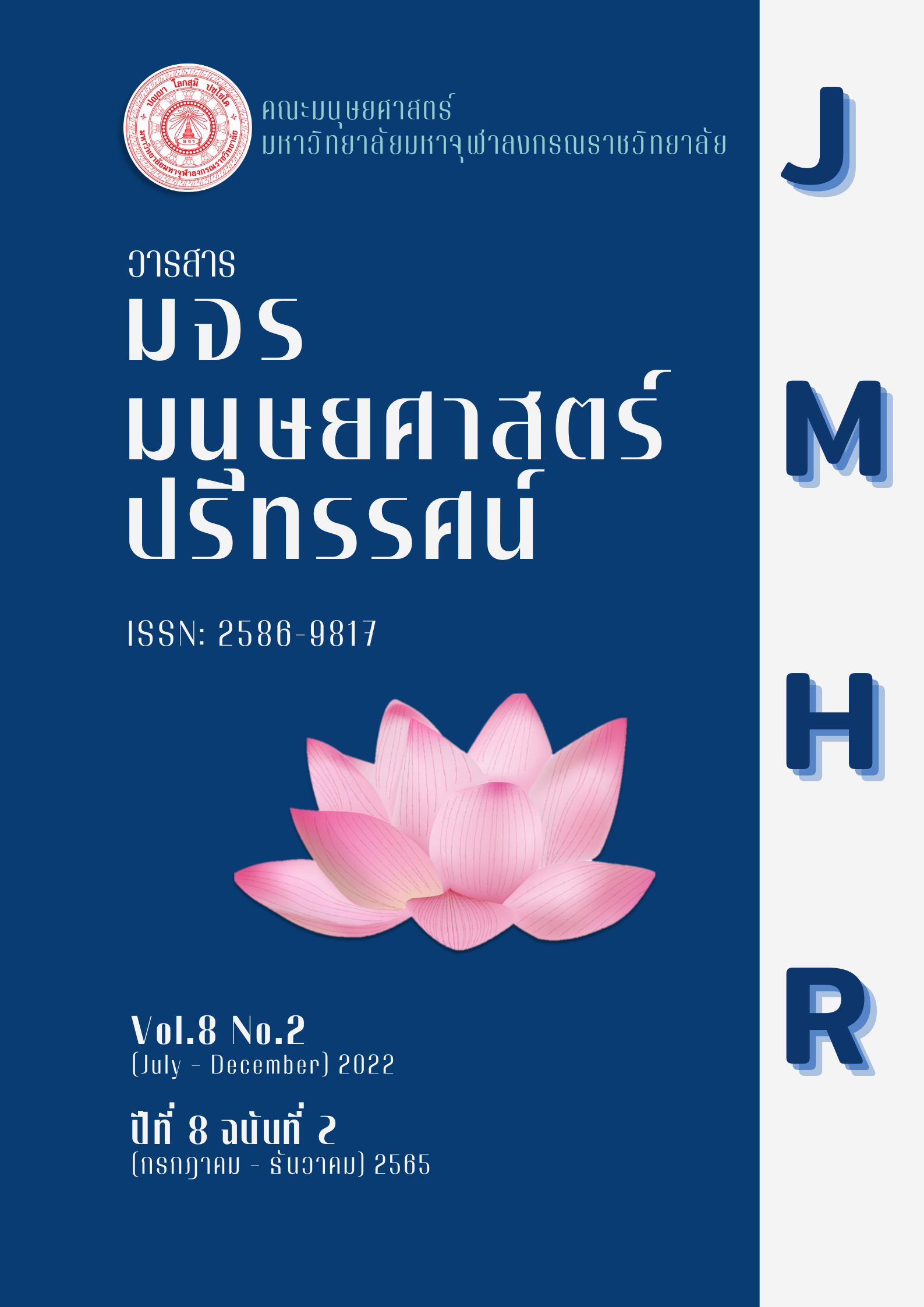ผลของโปรแกรมดนตรีพุทธบำบัดต่อการเพิ่มสมาธิต่อเนื่องสำหรับนักเรียน ที่มีความต้องการพิเศษระดับมัธยมศึกษาตอนต้น โรงเรียนพิบูลประชาสรรค์ กรุงเทพมหานคร
คำสำคัญ:
โปรแกรมดนตรีพุทธบำบัด, การเพิ่มสมาธิต่อเนื่อง, นักเรียนที่มีความต้องการพิเศษ, ระดับมัธยมศึกษาตอนต้นบทคัดย่อ
งานวิจัยนี้มีวัตถุประสงค์ เพื่อ 1. ศึกษาแนวคิดทฤษฎีเกี่ยวกับหลักจิตวิทยาหลักดนตรีบำบัดและคลื่นเสียงบำบัด หลักพุทธศาสนา สำหรับพัฒนาสมาธิต่อเนื่องของนักเรียนที่มีความต้องการพิเศษระดับมัธยมศึกษาตอนต้น 2. พัฒนาโปรแกรมดนตรีพุทธบำบัดต่อการเพิ่มสมาธิต่อเนื่องของนักเรียนที่มีความต้องการพิเศษระดับมัธยมศึกษาตอนต้น และ 3) นำเสนอผลของโปรแกรมดนตรีพุทธบำบัดต่อการเพิ่มสมาธิต่อเนื่องของนักเรียนที่มีความต้องการพิเศษระดับมัธยมศึกษาตอนต้น กลุ่มตัวอย่างเป็นนักเรียนที่มีความต้องการพิเศษที่ผ่านการวินิจฉัยจากจิตแพทย์เด็กและวัยรุ่นว่าเป็นเด็กกลุ่มอาการออทิสติกสเปคตรัม กำลังศึกษาระดับชั้นมัธยมศึกษาตอนต้นปีที่ 1-3 ชั้นเรียนพิเศษของโรงเรียนพิบูลประชาสรรค์ กรุงเทพมหานคร ปีการศึกษา 2563 ที่มีอายุระหว่าง 12– 18 ปี ได้มาจากการคัดกรองความเสี่ยงภาวะสมาธิสั้นจากแบบประเมินพฤติกรรม SNAP-IV (Short Form) สำหรับผู้ปกครองและสำหรับครู จำนวน 9 คน เข้ารับโปรแกรมดนตรีพุทธบำบัดจำนวน 1 เพลง ใช้เวลาฟังครั้งละ 20 นาที เป็นเวลา 8 สัปดาห์ ๆ ละ 5 วัน เครื่องมือที่ใช้ในการเก็บรวบรวมข้อมูลเชิงปริมาณและเชิงคุณภาพ ได้แก่ แบบทดสอบความสามารถในการทำงานอย่างต่อเนื่อง (PEBL Continuous Performance Task (PCPT ) และแบบประเมินพฤติกรรมการมีสมาธิ ติดตามผลหลังเสร็จสิ้นการทดลองเป็นระยะเวลา 1 เดือน โดยการสัมภาษณ์ผู้ปกครองทางโทรศัพท์ ตามรายการแบบประเมินพฤติกรรมการมีสมาธิ วิเคราะห์ข้อมูลด้วยค่าเฉลี่ย ค่าร้อยละ ส่วนเบี่ยงเบนมาตรฐาน และสถิติ Wilcoxon signed ranks test
ผลการศึกษาวิจัยพบว่า
- โปรแกรมดนตรีพุทธบำบัดที่พัฒนาขึ้น ประกอบด้วยเสียงสวดมนต์โพชฌงคปริตร ผสานกับเสียงดนตรีและเสียงธรรมชาติแทรกสอดคลื่นเสียงไบนอราลบีตส์แบบซ้อนทับ (Superimposed binaural beats) ที่ 10 เฮิรตซ์ (Hz) ใช้ระยะเวลาฟังครั้งละ 20 นาที เป็นเวลา 8 สัปดาห์ ๆ ละ 5 วัน
- 2. สมาธิต่อเนื่องของกลุ่มผู้เข้าร่วมการทดลองก่อนและหลังเข้าโปรแกรมดนตรีพุทธบำบัดไม่มีความแตกต่างกันอย่างมีนัยสำคัญทางสถิติ (p >0.05)
3. พฤติกรรมการมีสมาธิของกลุ่มผู้เข้าร่วมการทดลองก่อนและหลังเข้าโปรแกรมดนตรีพุทธบำบัดมีความแตกต่างกันอย่างมีนัยสำคัญทางสถิติ (p <0.05) และติดตามผลหลังเสร็จสิ้นการทดลองเป็นระยะเวลา 1 เดือน โดยการสัมภาษณ์ผู้ปกครองทางโทรศัพท์พบว่าหลังเข้าโปรแกรมดนตรีพุทธบำบัด ผู้เข้าร่วมการทดลองมีพฤติกรรมการมีสมาธิเพิ่มมากขึ้น การฟังดนตรีพุทธบำบัดทำให้เด็ก ๆ สนใจจะฟังบทสวดมนต์ เป็นวิธีที่ง่ายและสะดวก เด็ก ๆสามารถใช้เครื่องเล่น MP 3 เองได้ โดยไม่ต้องร้องขอให้ผู้ใหญ่มาช่วย นอกจากนี้ยังพบว่าช่วยผ่อนคลายความเครียด ทำให้เด็กนอนหลับสบาย และลดการทานยาปรับพฤติกรรมลงด้วย
เอกสารอ้างอิง
จเร สำอาง. (2550). สมองดี ดนตรีทำได้. กรุงเทพฯ : เดอะ เมจิก เบรน.
จักรกริช กล้าผจญ และคณะ. (2562). ผลของคลื่นเสียงไบนอราลบีตส์แบบซ้อนทับต่อการลดความวิตกกังวลของนักศึกษามหาวิทยาลัยในประเทศไทย. วารสารวิทยาศาสตร์ธรรมชาติมหาวิทยาลัยเชียงใหม่, 18(1), 125.
จิดาภา เกิดสุริวงษ์. (2557). การศึกษาผลของการฟังบทสวดมนต์โพชฌงค์ต่อการเปลี่ยนแปลงการทำงานของสมองในพุทธศาสนิกชนชาวไทย (วิทยานิพนธ์วิทยาศาสตรมหาบัณฑิต). มหาวิทยาลัยแม่ฟ้าหลวง : เชียงราย.
ณัทธร พิทยรัตน์เสถียร และคณะ. (2557). คุณสมบัติของแบบคัดกรองโรคสมาธิสั้นชื่อ Swanson, Nolan, And Pelham IV Scale (SNAP-IV) และ Strengths and Difficulties Questionnaire ส่วนที่เกี่ยวข้องกับ พฤติกรรมอยู่ไม่นิ่ง/สมาธิสั้น (SDQ-ADHD). วารสารสมาคมจิตแพทย์แห่งประเทศไทย, 59(2), 97-110.
นันทะวัน มะยะเฉี่ยว. (2552). ผลของการฟังเพลงธรรมะต่อคุณภาพการนอนหลับของผู้ป่วยสูงอายุในโรงพยาบาล (วิทยานิพนธ์พยาบาลศาสตรมหาบัณฑิต). มหาวิทยาลัยสงขลานครินทร์ : สงขลา.
เบญญาภา กุลศิริไชย. (2555). การลดภาวะซึมเศร้าในผู้ประสบภัยพิบัติด้วยการรับบทสวดโพชฌงคปริตรเข้าจิตใต้สำนึก (ดุษฎีนิพนธ์พุทธศาสตรดุษฎีบัณฑิต). มหาวิทยาลัยมหาจุฬาลงกรณราชวิทยาลัย : พระนครศรีอยุธยา.
ปาหนัน กฤษณรมย์. (2563). ผลของกิจกรรมดนตรีบำบัดต่อความสามารถในการรับรู้และตอบสนองต่อดนตรีพัฒนาการและคุณภาพชีวิตของเด็กออทิสติก. วารสารปาริชาต มหาวิทยาลัยทักษิณ, 33 (2), 169-180.
พัสมณฑ์ คุ้มทวีพร และคณะ. (2557). การเปรียบเทียบผลการสวดมนต์และการฟังเสียงสวดมนต์ต่อความเครียดและคุณภาพการนอนหลับของผู้ป่วยมะเร็งเต้านม. วารสารพยาบาลทหารบก, 15(2), 386.
พระพรหมคุณาภรณ์ (ป.อ.ปยุตฺโต). (2559). โพชฌงค์ พุทธวิธีเสริมสุขภาพ (พิมพ์ครั้งที่ 10). กรุงเทพฯ : พิมพ์สวย.
“_______”. (2540). สมาธิแบบพุทธ. รวบรวมจัดพิมพ์โดยพระครูปลัดสุวัฒนพรหมคุณ (อินศร จินฺตาปญฺโญ). นครปฐม: วัดญาณเวศกวัน.
พระวงศ์สรสิทธิ์ รติกโร. (2561). คุณค่าของการสวดมนต์ที่มีต่อพุทธศาสนิกชนไทย: กรณีศึกษาสำนักปู่สวรรค์. วารสารสังคมศาสตร์และมานุษยวิทยาเชิงพุทธ, 3(2), 89.
ยุ้กฟอง ศรีประสาธน์, วิทชา ชื่นอารมย์ และวัลลยา เบ้าพูนทอง. (2554). ผลของ Focus Cap ที่มีต่อสมาธิการทำงาน ของบุคคลบกพร่องทางพัฒนาการและสติปัญญา (รายงานวิจัย). กรุงเทพฯ : สถาบันราชานุกุล.
วินัดดา ปิยะศิลป์ และวันดี นิงสานนท์. (2558). คู่มือการตรวจประเมิน วินิจฉัย และแนวทางช่วยเหลือเด็กพิการ Children with Disabilities. กรุงเทพฯ : ห้างหุ้นส่วนจำกัด เพนตากอน แอ็ดไทซิ่ง.
ศศิวิมล พราหมณี. (2561). การเพิ่มความใส่ใจของนักเรียนระดับมัธยมศึกษาตอนปลายโดยใช้โปรแกรมฟังดนตรีที่แทรกสอดคลื่นเสียงแบบ Binaural Beats: การศึกษาศักย์ไฟฟ้าสมองสัมพันธ์กับเหตุการณ์ (ดุษฎีนิพนธ์ปรัชญาดุษฎีบัณฑิต). มหาวิทยาลัยบูรพา : ชลบุรี.
สมัย ศิริทองถาวร. (2560). หลักสูตรการฝึกอบรมบุคลากรทางการแพทย์ในการวินิจฉัย รักษา และดูแลเด็กที่มี อาการสมาธิสั้น. นนทบุรี: สถาบันวิจัยระบบสาธารณสุข.
สุพัตรา วงศ์วิเศษ แอนดราดี. (2560). พฤติกรรมและอารมณ์ในเด็กออทิสติก. กรุงเทพฯ : โรงพิมพ์แห่งจุฬาลงกรณ์มหาวิทยาลัย.
สุภาพรรณ เพิ่มพูน และคณะ. (2563). การฝึกสมาธิแนวพุทธเชิงสร้างสรรค์ในชีวิต ประจำวันสำหรับเยาวชนไทย. วารสารบัณฑิตศึกษาปริทรรศน์, 16(1), 24-36.
สำนักการแพทย์ทางเลือก กรมพัฒนการแพทย์แผนไทยและการแพทย์ทางเลือก. (2551). ดนตรีบำบัด. กรุงเทพฯ : บริษัทสุขุมวิทมีเดีย มาร์เก็ตติ้ง จำกัด.
Barkley RA. Murphy KR. (2011). The Nature of Executive Function (EF) Deficits in Daily Life Activities in Adults with ADHD and Their Relationship to Performance on EF Tests. JPsychopathol Behav Assess, 33, 137-158.
Gina R Poe, Christine M Walsh, & Theresa E Bjorness, (2010). Cognitive neuroscience of sleep. Nature Reviews Neuroscience, 3(9), 679-693.
Luca Vig et al. (2021). Sustained Attention Is Related to Heartbeat Counting Task Performance but Not to Self-Reported Aspects of Interception and Mindfulness”. Journal Consciousness and Cognition., 95, 1-9.
Susan Kenne et al. (2010). Pilot Feasibility Study of Binaural Auditory Beats for Reducing Symptoms Of Inattention in Children and Adolescents with Attention- Deficit/ HyperactivityDisorder. Journal of Pediatric Nursing. 25(1), 3-11.
Suvi Marjatta Pitkola. (2016). Effectiveness of SAMONAS Sound Therapy (SST) in Improving Social Engagement of Children with Autism Spectrum Disorder. Degree of Doctor of Philosophy Department of Music Therapy. The University of Melbourne. Australia.

ดาวน์โหลด
เผยแพร่แล้ว
รูปแบบการอ้างอิง
ฉบับ
ประเภทบทความ
หมวดหมู่
สัญญาอนุญาต
ลิขสิทธิ์ (c) 2022 วารสาร มจร มนุษยศาสตร์ปริทรรศน์

อนุญาตภายใต้เงื่อนไข Creative Commons Attribution-NonCommercial-NoDerivatives 4.0 International License.





